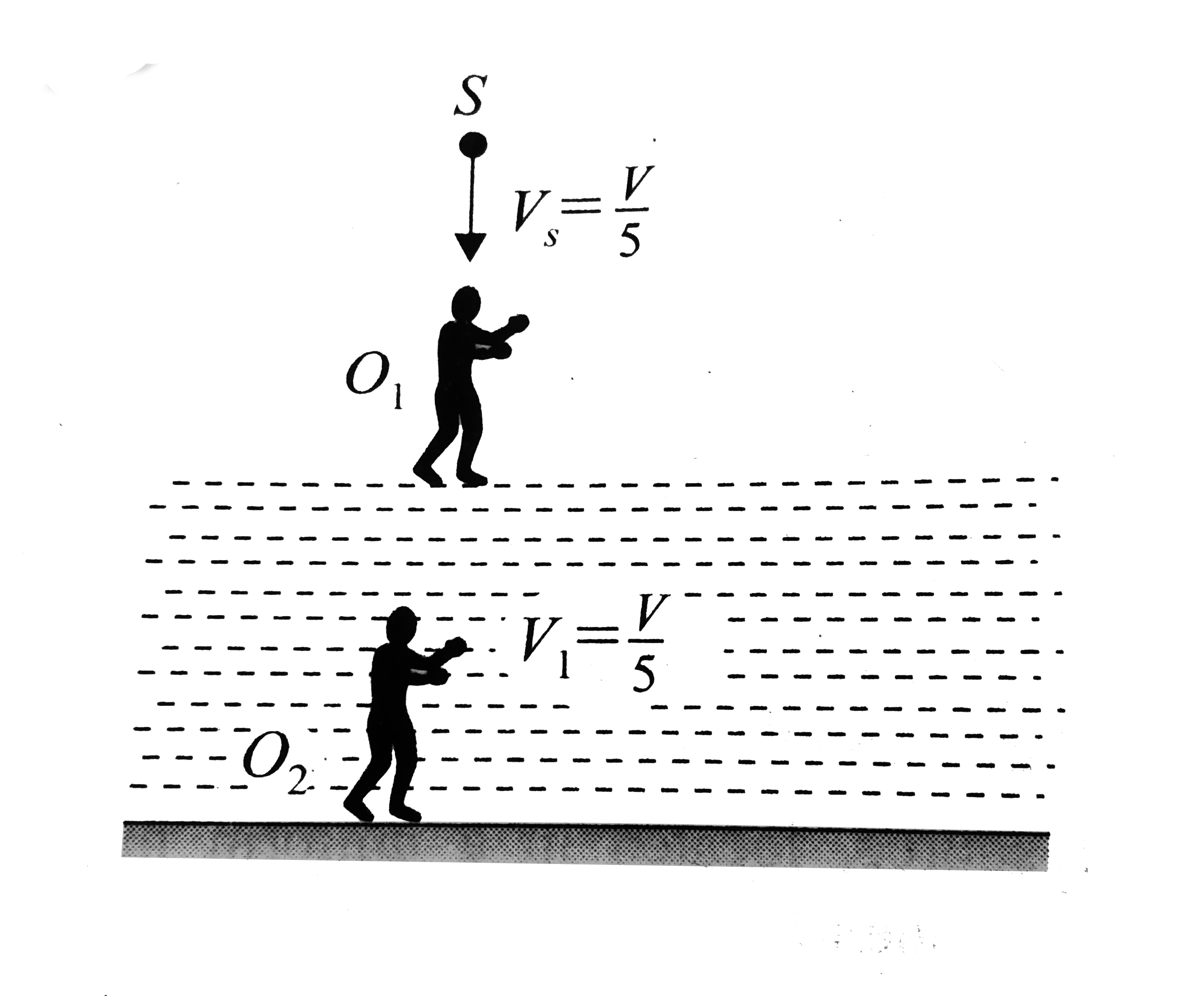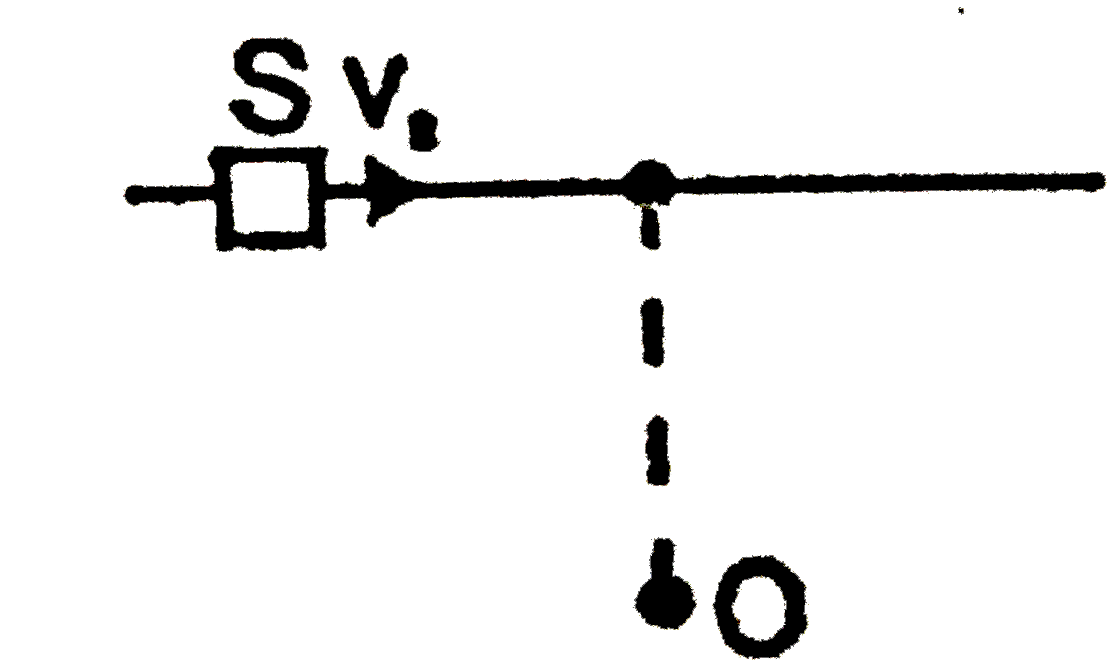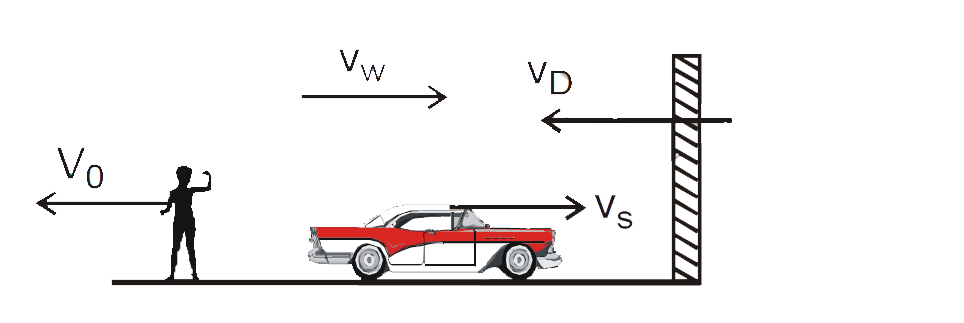In the figure shown an observer O1 floats static on water surface with ears in air while another observer O2 is moving upwards with constant velocity v1 = v/5 in water. The source moves down with constant velocity vs = v/5 and emits sound of frequency f. The velocity of sound in air is v and that in water is 4v. For the situation shown in figurea The wavelength of the sound received by O1 is 4v/ 5f b The wavelength of the sound received by O1 is v/ f c The frequency of the sound received by O2 is 21f / 16 d The wavelength of the sound received by O2 is 16v/ 5f
Correct option: a b cExplanation: For observer O1 For O2 there is change of medium hence at the surface of water keeping frequency unchanged
Related Solutions
In the figure shown an observer O_(i) floats (static) on water surface with ears in air while another observer O_(2) is moving upwards with constant velocity v_(1) = v//5 in water. The source moves down with constant velocity v_(2) = v//5 emits sound of frequency /. The velocity of sound in air is v and that in water is 4v. For the situation shown in figure:
View Solution
In the figure shown, an observer floats (static) on water surface with ears in air while another observer is moving upwards with constant velocity in water. The source moves down with constant velocity and emits sound of freqeuncy . The velocity of sound in air is and that in water is . For the situation shown in figure.View Solution
In the figure shown, an observer floats (static) on water surface with ears in air while another observer is moving upwards with constant velocity in water. The source moves down with constant velocity and emits sound of freqeuncy . The velocity of sound in air is and that in water is . For the situation shown in figure.View Solution
In the figure shown, an observer floats (static) on water surface with ears in air while another observer is moving upwards with constant velocity in water. The source moves down with constant velocity and emits sound of freqeuncy . The velocity of sound in air is and that in water is . For the situation shown in figure.View SolutionA source of sound emitting a note of frequency 200 Hz moves towards an observer with a velocity v equal to the velocity of sound. If the observer also moves away from the source with the same velocity v, the apparent frequency heard by the observer is
View SolutionA source of sound emitting a note of frequency 200 Hz moves towards an observer with a velocity v equal to the velocity of sound. If the observer also moves away from the source with the same velocity v, the apparent frequency heard by the observer is
View SolutionIf a source emitting waves of frequency f moves towards an observer with a velocity (v)/(4) and the observer moves away from the source with a velocity (v)/(6) , the apparent frequency as heard by the observer will be (v=velocity of sound)
View SolutionIf a source emitting waves of frequency f moves towards an observer with a velocity and the observer moves away from the source with a velocity , the apparent frequency as heard by the observer will be ( velocity of sound)
View SolutionIf a source of frequency n moving with velocity v crosses a stationary observer, then the change in the frequency of sound heard by the observer will be (velocity of sound = V)
View SolutionIf an observer is moving with uniform velocity v to wards a stationary source of frequency n, and if the velocity of sound in the medium is V, then the apparent change in the frequency of the sound, heard by the observer, is -
View Solution
A wall is moving with constant velocity towards a fixed source of sound of frequency . The velocity of sound is . The wavelength of the sound reflected by the wall isView SolutionA source of sound crosses a stationary observer which is moving with uniform velocity v. If the velocity of sound in air is V, then the ratio of the apparent frequencies heard by the observer before and after the source crosses him would be -
View SolutionThe source (S) of sound is moving constant velocity as shown in diagram. An observer O listens to the sound emmited by the source. The observed frequency of the sound
 View Solution
View SolutionThe source (S) of sound is moving constant velocity v_(0) as shown in diagram. An observer O listens to the sound emmited by the source. The observed frequency of the sound
View SolutionA source of frequency n is moving with a uniform velocity v towards a stationary observer. If the velocity of sound is V, then the change in frequency would be -
View SolutionA sound source of frequency 200 Hz comes towards an observer with a velocity equal to the velocity V of the sound. If the observer also moves away from the source with the same V velocity, then the observer will have a virtual frequency.
View SolutionThe observer is moving with velocity 'v'_(0) towards the stationary source of sound and then after crossing moves away from the source with velocity 'v'_(0) . Assume that the medium through which the sound waves travel is at rest. If v is the velocity of sound and n is the frequency emitted by the source, then the difference between appearent frequencies heard by the observer is
View SolutionTwo sources S_1 and S_2 of same frequency f emits sound. The sources are moving as shown with speed u each. A stationary observer hears that sound. The beat frequency is ( v= velocity sound)
View SolutionS,O & W represent source of sound (of frequency f), observer & wall respectively. are velocity of observer, source, wall & sound (in still air) respectively. is the velocity of wind. They are moving as shown. Find

The wavelength of the waves coming towards the observer from source.View SolutionThe speed of sound in air is v. The velocity of a source of sound whose frequency appears to be doubled to a stationary observer is
View Solution
